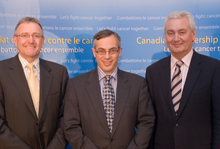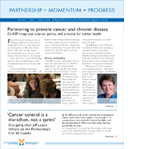Out-going Chair Jeff Lozon reflects on the Partnership’s first 30 months
"Cancer control is a marathon, not a sprint"
April 21, 2009
Q. In 2006 you took on the critical role of inaugural Chair, before there was staff or even an office – it was just you, Vice-Chair Dr. Simon Sutcliffe, and the interim Board. What was that early start-up period like for you?

A. It’s important to note that the Partnership really began years before, when hundreds of people worked to develop the Canadian Strategy for Cancer Control.
When the federal government announced the Partnership in November 2006, there was enormous challenge to roll out in a short time. We brought in the transition team, which was responsible for the detailed negotiations for interim and longer-term Funding Agreements – and those agreements were a big job!
We also had to review the Strategy document with the people who created it. A fair bit of time was spent working with the existing Action Groups, explaining what had to be done to translate the Strategy from a document into programs.
Starting the Board was also a big item. We were fortunate in having the right type of people join, and fortunate that they all agreed immediately. That itself is a testament to the Strategy, and to the promise that the Partnership represents.
In all, the start-up phase was a full year of working on those bigger items, plus all the smaller items, such as finding space, leasing arrangements, and the like. You’re climbing a different mountain every day.
Q. Does a highlight stand out?

A. Yes, the euphoria around the announcement by the Prime Minister was exciting. That [November 2006] announcement punctuated a level of success for the entire cancer community, and all the work that they had put into the Strategy. It was a highlight for everyone when it became a reality.
Another highlight for me was the inaugural Board meeting, with all those committed directors from across Canada in the room for the first time.
On a personal note, the highlight for my entire term has been getting to meet so many wonderful people, and seeing how much hope was put into this by people right across Canada.
Q. Was there a particular challenge in the start-up phase?
A. First of all, this was not a classic start-up because although we were starting the organization itself, the Action Groups were already functioning, and they needed support right away.
We also had to manage expectations. The whole cancer community came into this with many, many high expectations.
As well, during start-up it was clear that there needed to be a tighter focus brought to the Strategy, which was a broad-based planning document. Our principal job was to pick what we could deliver on – and focus on those key initiatives.
I think we’ve done a good job of setting up the Partnership to deliver the Strategy, and also in managing expectations. Now people realize that this is a marathon, not a sprint.
Q. What is the difference between creating a strategy and an organization?
A. When you are moving from the planning stage to execution of the plan, the focus of control needs to change. That is not an easy transition, but it is necessary. With the funding announcement, as one person put it, the work moved from the corner of the desk to the centre of it.
Hundreds of people were involved in creating the Strategy document, and they should be very proud of their contributions. When the Partnership started, the effort became more focused. I think that the Partnership has managed this transition well. We have also brought new people to the table, which is exciting.
“We now have the best of both worlds, with broad-based participation on the ground, in an organization that can deliver.”
– Partnership Chair Jeff Lozon
When the Partnership was announced, it was like the dog that caught the bus – “Now what do I do with it?” It’s one thing to ask for funding, but it’s another to spend money wisely and to implement a meaningful structure. (For instance, the Action Groups that had come together before the Partnership was established were then required to do different things, and in a compressed time frame.) It was an essential transition.
I believe that we now have the best of both worlds, with broad-based participation on the ground, in an organization that can deliver.
Q. How would you characterize what is unique about the Partnership?
A. The uniqueness is three-fold. First, the organization was created to execute a strategy that already existed. Second, that process involved many different stakeholders, including the federal government, provincial and territorial governments and cancer agencies, patient and survivor organizations, and dozens of others. The patient and survivor role is critical and unique, and the fact that this is a national organization is a big feature. Third, this organization is focused on “control” of a single disease across the whole country.
No other agency is like this, to my knowledge.
Q. As the inaugural Chair you have a specific perspective. What do you hope for the Partnership five years from now?
A. I believe that five years from now this will be the go-to agency for cancer control in Canada. It will have many national features and involve all the key stakeholders and audiences. I also believe that it will be increasingly recognized internationally, which is important.
The Partnership won’t necessarily be fully mature, but its role will have blossomed. It will be stable and it will be devoted to delivering cancer control across Canada.
The federal government, to its credit, says it wants to see measurable change in how many people get cancer, how many people die of cancer, and how people live with cancer. Ultimately those are the yardsticks against which the Partnership will be measured.
The Partnership’s obligation is to make sure that it executes the planning document, and its real promise is in that execution.
Q. On a personal level, what do you take from your role as inaugural Chair?
A. Speaking as someone who has been in health care for more than 30 years, when my Partnership appointment was announced I heard from more people, and I had more notes of congratulation, than I ever had before. It was tremendously exciting to do something so worthwhile. I remember vividly the patients and survivors whom I met in the early days – their passion, bravery, and courage. Their contribution is remarkable.
We have been helped along the way by the federal government, provincial and territorial governments, cancer agencies, and by hundreds of health-care providers and survivors who have given their time and talent to make the Partnership what it is today.
It has been a privilege to be involved in the active creation of the Partnership. I’ll be watching its success for many years to come.
 The article above is also available in the Partnership’s Spring 2009 newsletter. If you, or your organization, would like printed copies of the newsletter please contact us.
The article above is also available in the Partnership’s Spring 2009 newsletter. If you, or your organization, would like printed copies of the newsletter please contact us.
To receive e-bulletins about Partnership activities, please subscribe.
